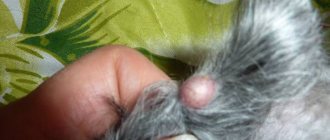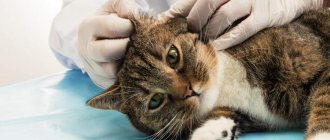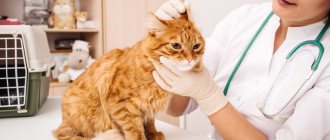12200Administration
2
When a cat has a sore on his ear, this is not an independent problem. This is how the cat’s body heals wounds and blocks viruses from entering the blood. Of greater concern are the reasons why the cat began to scratch the ears and the skin around them until they bled.
Many of them can only be accurately determined in a veterinarian's office. A particularly dangerous additional symptom is baldness. In this case, it is important to correctly identify the cause of the disease and begin to treat it in time.
© shutterstock
Symptoms of ear diseases
Caring owners can detect the onset of the disease in time by periodically checking the condition of their pet’s ears. An independent attempt to diagnose an animal can lead to progression of the disease. If any alarming signs occur, you should consult a doctor.
The following symptoms indicate the occurrence of pathology:
- Discharge. If there is yellow or brown discharge with a strong odor, you need to clean your pet's ears. If this does not help resolve the problem, you need to contact a veterinary clinic.
- Itching. If your cat scratches its ears more than twice a day, it should be examined.
- Hyperemia. The development of pathology is indicated by redness of the animal's ear.
- Edema. Due to the fact that cats' ears are rarely checked, it is difficult to pay attention to swelling. The reason to see a doctor should be a decrease in the free space in the auricle and the diameter of the ear canal.
- Hyperthermia. As the disease progresses, the ears may become hot.
- "Squish" effect. If an animal's ear is dented, the affected ear will make characteristic squelching sounds.
- Head tilt. When ear disease develops, the pet tilts its head in the direction from which it feels discomfort.
Severe itching is one of the symptoms of ear disease.
Causes of crusts on a cat's ears
The crusts that form on the soft tissues of the animal usually consist of dead particles of the dermis, dried ichor or pus, and coagulated blood. In color they can be brown, yellow-gray, brown. Let's consider the possible causes of the pathological condition.
Parasites (fleas, ticks)
Blood-sucking insects often accumulate on areas of the body that are most difficult for an animal to reach - on the withers, in the ear area, on the neck. The bites cause itching, inflammation and minor bruising. The cat will scratch the skin, after which traces will remain in the form of dried crusts.
Otodectosis is an ear mite that infects cats, dogs and many other animals. It penetrates deep into the soft tissues of the auditory organs and parasitizes there. A sign of otodectosis is dark crusts in the ears. May be observed: redness, ichor, swelling. If the pet is not treated, the tick leads to severe inflammation and deafness.
The otodeca mite is microscopic and invisible to the human eye. The only symptoms that indicate its parasitism are crusts on the cat’s ears. To confirm the diagnosis, it is necessary to undergo a test. To get rid of otodectosis, drops and special preparations for washing the ears are prescribed.
Allergy
Allergic reactions in a pet can occur to anything - food, dust, household chemicals used in the house, litter tray, etc. Allergic dermatitis appears most often on soft tissues and where the skin is the most delicate and thin. The affected areas become covered with spots, rashes, blisters, and crusts later form in their place. The allergy is accompanied by itching and the cat will scratch the rash.
When an allergy is diagnosed, antihistamines are prescribed. To eliminate external symptoms, ointments and tinctures are used for rubbing. It is very important to remove the allergen immediately, otherwise the treatment will be temporary.
Fungal infections (mycoses)
This group includes various lichens and dermatomycoses caused by fungal microorganisms. Some of them are transmitted to people. If a cat has crusts on the tips of the ears, in the shell itself, next to the ear, this is a sign of lichen. Associated symptoms of fungal infections: hair loss, peeling, suppuration or bleeding from affected areas, unpleasant odor. The discharge gradually dries out and forms sores and crusts.
For the treatment of dermatomycosis, fungicidal preparations are used in the form of ointments, liquids, drops. The animal may also be prescribed antifungal medications to take orally. With timely treatment, the prognosis is favorable - the pet recovers quickly and hearing loss does not occur.
In domestic cats that go outside, frostbite and hematomas are the cause of the formation of crusts. A cat's ears are not protected by a lot of fur, and their cartilage is very thin - they quickly freeze in extreme cold. The dead tissue gradually begins to peel off, but first a crust appears.
Ear diseases in cats
There are several of the most common pathologies of the auricle in cats. In the absence of proper therapy, even due to fungal infection, the animal may lose hearing or die. It is worth considering that some diseases manifest themselves only by the formation of crusts in the absence of any other symptoms.
Allergy
If the cause of the formation of crusts is a food allergy, then the pet needs to be switched to high-quality food and choose a balanced diet. It is important to ensure that the products are fresh and natural. By adjusting the diet, the crusts in the ears of a kitten or adult animal will gradually disappear on their own.
Scabies mite
This pathology is also called otodecosis. It is quickly transmitted from a sick animal to a healthy one and is characterized by damage to the auricle by mites.
With odecosis, the animal's ears are covered with a dark coating with a pungent odor.
The inside of your pet's ears become covered with a dark coating with a pungent odor, and severe itching is observed.
If left untreated, the mite moves deeper and affects the inner ear.
Dermatitis and eczema
Dermatitis is often the result of allergies, eczema, or damage to the animal’s body by parasites. The formation of scabs and wet ulcers, itching, and accumulation of discharge with an unpleasant odor are observed. The disease is not dangerous for healthy cats. Therapy consists of eliminating the root cause and subsequent local treatment of the affected area.
We recommend this article:
Basic types and rules for treating eczema in cats
Necrosis of the auricle
Causes of pathology:
- infection of an existing wound on the ear;
- severe injury, prolonged compression of tissue, frostbite, cut;
- spread of the existing purulent process to the auricle.
In the affected organ, blood circulation is disrupted, and tissue begins to rot and die. This is often observed in cats that live outside or spend a lot of time in the cold. The solution to the problem is complete or partial amputation.
Neoplasms
A benign or malignant tumor can form in the purr's ear: papilloma, fibroma, sarcoma. The ear canal is gradually blocked, and the coordination of the animal’s movements is disrupted. Pathology requires surgical intervention.
Hematoma
Occurs as a result of injury, bite, scratching or any other strong mechanical impact. The auricle swells, turns red, and becomes hot. Severe pain syndrome develops. The animal becomes restless and shakes its head. In the clinic, the hematoma is opened and the contents are cleaned out. An ointment is placed inside, for example, “Levomekol”. The procedure is repeated until the symptoms are completely eliminated.
Hematoma occurs as a result of injury
Ulcers
Wounds in a cat's ears indicate a fungal infection. In this case, the formation of small wounds, pimples, blisters with pus or yellow liquid is observed. After they burst, scabs appear.
In this case, you cannot use ointment. At the clinic, a scraping will be taken from the animal to determine the causative agent of the disease and select a drug to which the pathogens are sensitive. To dry the ulcers, Streptocide powder is used.
Inflammatory processes, otitis media
Causes of the disease:
- tick damage;
- formation of neoplasms;
- ear getting wet;
- injury;
- infection.
The main symptoms of damage to the outer ear are itching and excessive production of wax. If the inflammatory process spreads deeper, the pet experiences pain and shakes its head. There is the release of purulent exudate with an unpleasant odor and hyperthermia. The cat's body temperature may rise. The animal is prescribed antibiotics and local treatment of the affected areas.
Lymphextravasate
Can develop as a result of any injury. Characterized by the accumulation of large amounts of lymph under the skin. Lymphatic extravasation does not pose a threat to the life and health of the pet. For a long time there are no external signs of pathology, there is no hyperthermia. As part of the therapy, accumulated lymph is pumped out with a syringe in a veterinary clinic. Sometimes it is necessary to completely open the resulting cavity, after which sutures are applied.
Veterinarian advice
Veterinarians advise owners to constantly monitor the condition of their cats' ears. Many animals produce a lot of sulfur, which should be cleaned regularly, otherwise inflammation may develop.
After bathing your cat, remove any water that gets into the ear canal. If this is not done, otitis may develop. Make sure that your pet does not come into contact with animals infected with ticks, because this disease is quickly and easily transmitted.
Each owner is obliged to monitor the condition of his cat and, if necessary, show it to a veterinarian. Don't forget that many ear diseases can lead to complete deafness if not treated promptly.
Cats! In Ancient Egypt, they were considered sacred, and the government of Cyprus subsidized funds for their maintenance, because the mustachioed predators once saved the island from an invasion of snakes. How wonderful it is when they are in the house, delighting the owners with games and excellent health. An attentive owner will immediately determine that something incomprehensible is happening to his pet. When he tries to pat her on the head, she begins to growl and shows aggression. Unfortunately, ear diseases in cats are quite common. And you can’t underestimate them if you don’t want your pet to go deaf.
Diagnostic methods
To choose the right treatment, you need to accurately determine the diagnosis. The following methods are used for this:
- general examination;
- scraping;
- microbiological study of hair roots during the formation of bald patches;
- general and biochemical blood test;
- Ultrasound, x-ray if the formation of a neoplasm is suspected.
If your cat is in pain, it will be difficult to examine him. It is important to follow all safety precautions during examination in case the disease could be dangerous to humans.
General examination Scraping General and biochemical blood test
Prevention
Every owner should regularly inspect their cat's ears at home for the appearance of excessive discharge, scabs, ulcers or other signs of disease. If your pet starts shaking its head, scratching its ear vigorously, or has a fever, this is a reason to consult a veterinarian.
Untreated ear diseases can lead to serious complications. If the inflammation spreads to the inner ear, the animal may become deaf.
Many diseases are accompanied by severe itching and pain, so it is necessary to start treatment on time.
Effective Treatments
Therapy is selected based on the diagnostic results and the identified cause of the pathology:
- Allergy. Changing your pet's diet, changing food.
- Mite. It is recommended to bury the ears with Tsipam or Stronghold drops. It is important to regularly carry out hygiene procedures, cleansing the affected skin of dark plaque.
- Lichen. Requires immediate treatment. Sulfur ointment or “Yam” remedy is prescribed. It is important to be careful until your pet recovers so that the disease does not spread to people.
- Hematoma, neoplasm. Surgical intervention is performed with further local treatment of the wound.
We recommend this article:
How to recognize and properly treat ringworm in a cat
We recommend this article:
Characteristic symptoms of allergy to cats, diagnosis and treatment of pathology
How to recognize symptoms
It is impossible to independently determine the exact cause and nature of the disease. However, the very fact that a purring dog has problems with its ears manifests itself quite clearly so as not to go unnoticed.
The following signs will indicate the need for veterinary care:
- the cat scratches its ears, sometimes tearing them to the point of bleeding;
- crusts, scabs, ulcers and blisters form outside and inside the affected organ;
- tissues become swollen and red;
- when you touch your ears, they begin to hurt;
- discharge of fluid, brown or black coating;
- unpleasant odor from the ears;
- increased body temperature;
- swollen lymph nodes;
- lethargy or, conversely, restless behavior;
- loss of appetite.
How to prevent the development of the disease
Ear diseases are common among cats. There are a number of simple rules to avoid the development of pathology:
- Regular examination of your pet's ears and careful cleaning.
- Avoiding hypothermia, frostbite, and getting your ears wet.
- Proper nutrition.
- Timely vaccination. This is especially important if your pet goes outside.
- Limit contact with other animals if the cat is indoor and does not go outside.
Timely vaccination is a way to prevent the development of diseases.
A purring fluffy is not a toy, but a living creature, and every cat owner is responsible for his pet. If any changes in the animal's behavior occur, it should be examined and consulted with a doctor.
Recommended Posts
How to cure demodicosis in a dog and save your pet’s life
Basic symptoms and rules for treating cystitis in cats
Causes and methods of treating acne in cats
The first symptoms and features of treatment of piroplasmosis in dogs
Possible causes, methods of diagnosis and treatment of black feces in cats
Symptoms and popular treatments for staphylococcus in dogs
What is flaking and how does it manifest itself in bald people?
Peeling is the formation of scales (squama), keratinized pieces of the epidermis. The separation of keratinized particles of the epidermis occurs constantly and is a normal physiological process, that is, the skin is renewed. With various skin diseases, this process intensifies. Scales can be separated either in very small (pityriasis-like) pieces or in plates. Depending on the underlying disease, the skin may be swollen, hyperpigmented, or, on the contrary, thin out and become almost transparent and reddish.
Peeling of the skin in Sphynx cats develops for many reasons, and often occurs when the air in the room where the cat lives is too dry. Let's look at the main causes of dry and flaky skin in cats.
- Sunburn. Since sphinxes do not have fur, nothing protects their skin.











